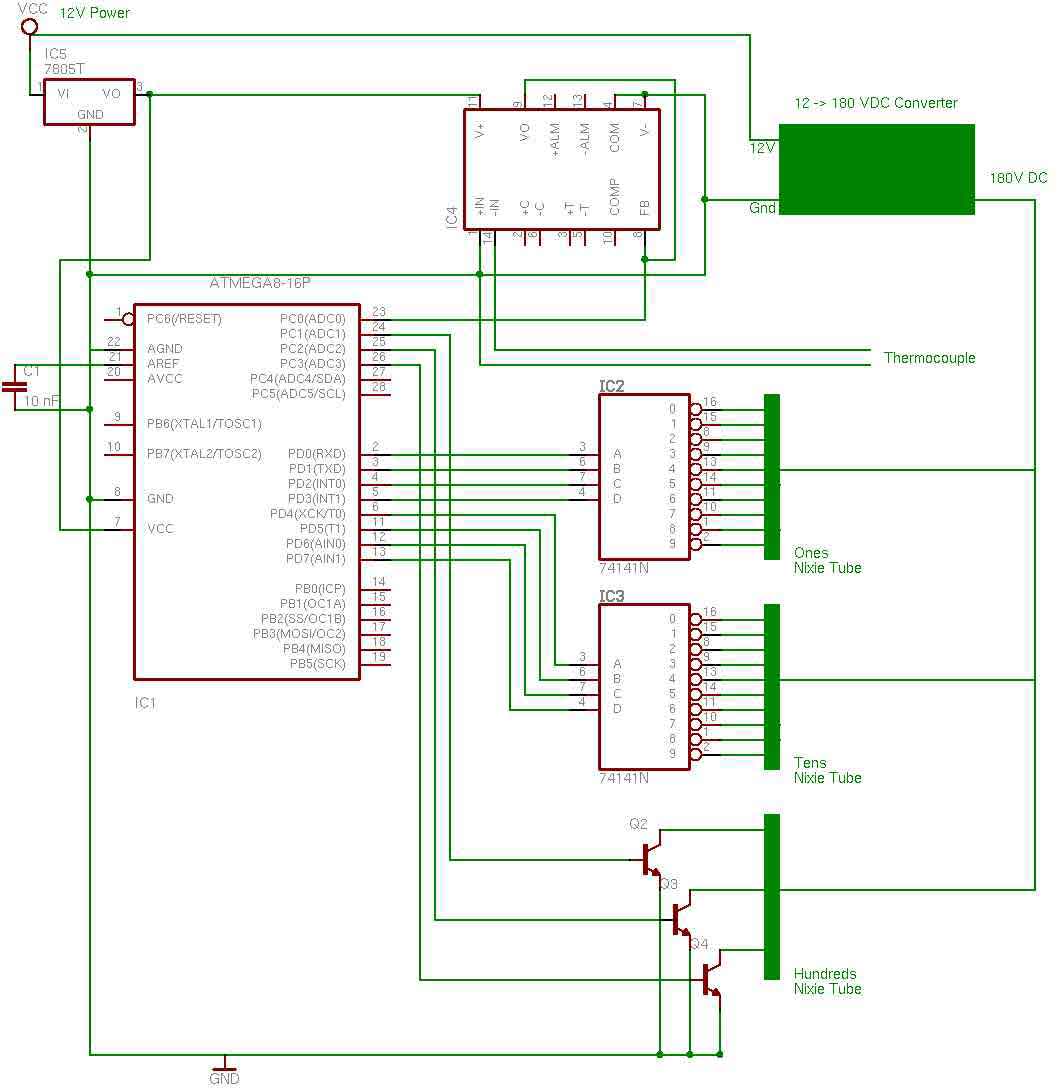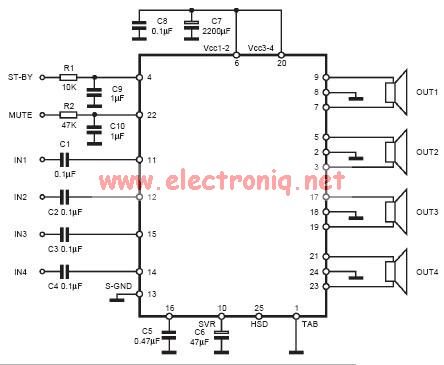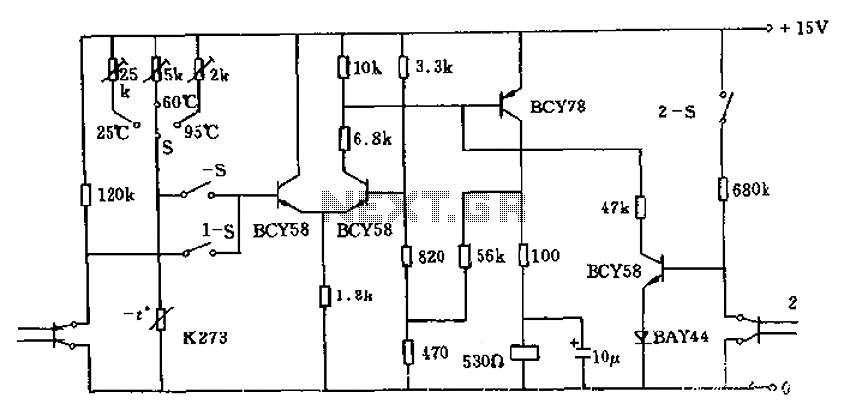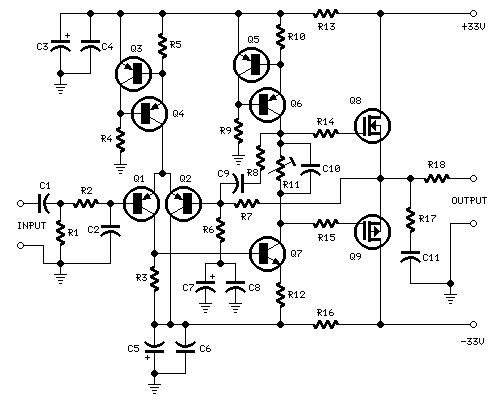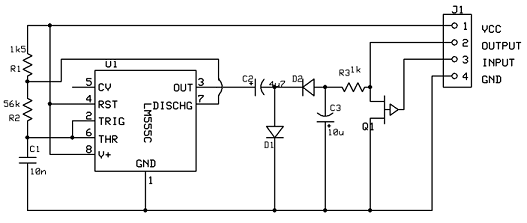
DC-coupled multi-stage amplifier circuit b
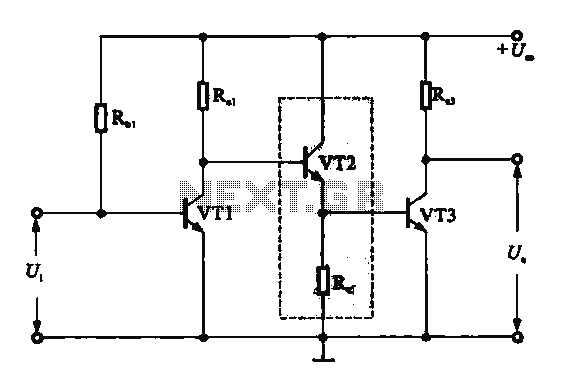
A DC-coupled multi-stage amplifier circuit consists of multiple stages of amplification using a DC-coupled configuration. Each stage utilizes NPN-type transistors, which are designed to maintain appropriate operating points at the base of each stage. As the signal progresses through the amplifier, the collector potential increases progressively, which can lead to a reduction in the overall output voltage range. To address this issue, a combination of NPN and PNP transistors can be employed to lower the DC potential of the output stage. This is illustrated in the accompanying figure, where an NPN transistor (VT1) and a PNP transistor (VT2) are utilized to manage the voltage levels of the subsequent stage (VT3). Additionally, an emitter follower configuration can be implemented to further reduce the DC potential of the circuit, as depicted in another figure that shows the use of an emitter follower to lower the potential of the next stage (VT3).
The DC-coupled multi-stage amplifier circuit is designed to provide high gain while maintaining linearity across the amplification stages. Each stage is carefully biased to ensure that the transistors operate in their active regions, thus allowing for efficient signal amplification. The use of NPN transistors in the initial stages capitalizes on their high current gain characteristics, while the inclusion of PNP transistors helps to stabilize the output voltage by counteracting the rising DC levels that can occur through cascading stages.
In this configuration, the collector of each NPN transistor connects to the base of the subsequent transistor, creating a chain of amplification. The base biasing resistors are selected to set the appropriate quiescent operating points, ensuring that each transistor remains within its linear operating range. The progressive increase in collector potential is managed by the strategic placement of PNP transistors, which serve to pull down the voltage levels as needed, thereby preventing saturation and distortion in the output signal.
The emitter follower configuration is particularly useful in this design as it provides a low output impedance, which is advantageous for driving loads. This stage can effectively isolate the previous amplification stages from the load, allowing for improved signal integrity and reduced loading effects. By using diodes in conjunction with the emitter follower, the circuit can further clamp the DC levels, ensuring that the output remains stable across varying input conditions.
Overall, this DC-coupled multi-stage amplifier circuit exemplifies a robust design approach for achieving high fidelity amplification in various electronic applications, from audio processing to signal conditioning in instrumentation. Proper component selection and biasing are critical to the performance of the circuit, ensuring that it meets the desired specifications while minimizing distortion and maintaining a wide dynamic range.DC-coupled multi-stage amplifier circuit b (3) multi-stage DC-coupled amplifier in DC-coupled by a multi-stage amplifier circuit amplifying circuit, if used NPN type transistor of each stage, in order to fit all levels have appropriate operating point of stage base, Step by step the collector potential increases, so reducing the final output voltage range. In order to solve this problem, in practice, it can be used in conjunction with NPN and PNP transistor to reduce the post-stage DC potential, as shown in FIG.
Figure (8) shows an NPN cvri) _ and PNP transistor (VT2) wish, is used to reduce the subsequent stage (VT3) potential. Alternatively, you can use emitter follower, stage amplified voltage diode to reduce a DC potential of the circuit.
Figure (b) shows the use of emitter cvn) is used to reduce the subsequent stage (, rr3) potential.
The DC-coupled multi-stage amplifier circuit is designed to provide high gain while maintaining linearity across the amplification stages. Each stage is carefully biased to ensure that the transistors operate in their active regions, thus allowing for efficient signal amplification. The use of NPN transistors in the initial stages capitalizes on their high current gain characteristics, while the inclusion of PNP transistors helps to stabilize the output voltage by counteracting the rising DC levels that can occur through cascading stages.
In this configuration, the collector of each NPN transistor connects to the base of the subsequent transistor, creating a chain of amplification. The base biasing resistors are selected to set the appropriate quiescent operating points, ensuring that each transistor remains within its linear operating range. The progressive increase in collector potential is managed by the strategic placement of PNP transistors, which serve to pull down the voltage levels as needed, thereby preventing saturation and distortion in the output signal.
The emitter follower configuration is particularly useful in this design as it provides a low output impedance, which is advantageous for driving loads. This stage can effectively isolate the previous amplification stages from the load, allowing for improved signal integrity and reduced loading effects. By using diodes in conjunction with the emitter follower, the circuit can further clamp the DC levels, ensuring that the output remains stable across varying input conditions.
Overall, this DC-coupled multi-stage amplifier circuit exemplifies a robust design approach for achieving high fidelity amplification in various electronic applications, from audio processing to signal conditioning in instrumentation. Proper component selection and biasing are critical to the performance of the circuit, ensuring that it meets the desired specifications while minimizing distortion and maintaining a wide dynamic range.DC-coupled multi-stage amplifier circuit b (3) multi-stage DC-coupled amplifier in DC-coupled by a multi-stage amplifier circuit amplifying circuit, if used NPN type transistor of each stage, in order to fit all levels have appropriate operating point of stage base, Step by step the collector potential increases, so reducing the final output voltage range. In order to solve this problem, in practice, it can be used in conjunction with NPN and PNP transistor to reduce the post-stage DC potential, as shown in FIG.
Figure (8) shows an NPN cvri) _ and PNP transistor (VT2) wish, is used to reduce the subsequent stage (VT3) potential. Alternatively, you can use emitter follower, stage amplified voltage diode to reduce a DC potential of the circuit.
Figure (b) shows the use of emitter cvn) is used to reduce the subsequent stage (, rr3) potential.
